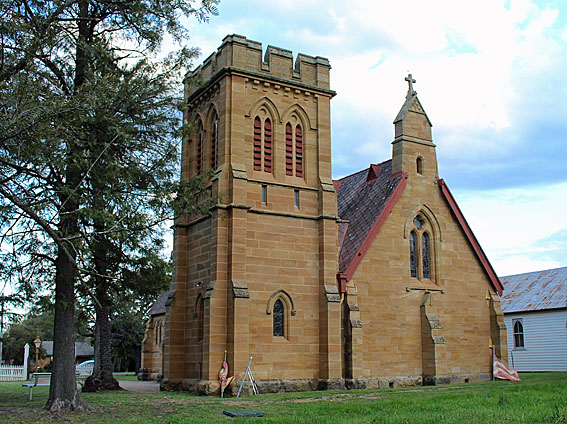
St Paul's Anglican Church, Murrurundi: exterior from the west
[photograph by Trevor Bunning (1 October 2015)]

St Paul's Anglican Church, Murrurundi: exterior from the west
[photograph by Trevor Bunning (1 October 2015)]
Historical and Technical Documentation by Kelvin Hastie and Peter Jewkes
© OHTA, 2015 (last updated September 2015)
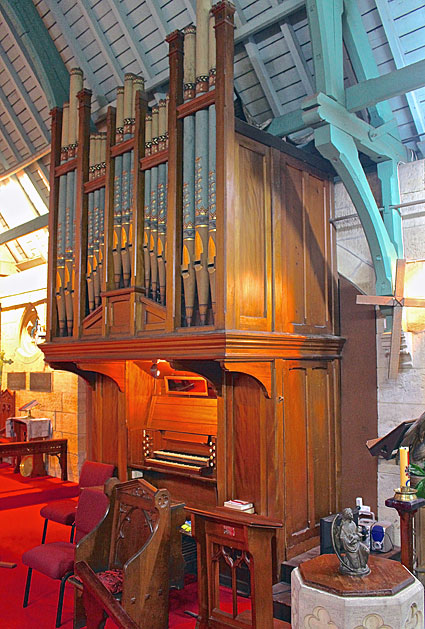
St Paul's Anglican Church, Murrurundi: organ
[photograph by Trevor Bunning (1 October 2015)]
St Paul's Anglican Church stands in a picturesque setting alongside the Pages River at Murrurundi in the Upper Hunter Valley. Designed 1872 by Horbury Hunt and commissioned by the White family, the foundation stone was laid on 24 April 1873 and the building opened on 24 June 1874. It was built from local sandstone with a western turret surmounting the roof ridge. The tower was completed in 1913 as a memorial to Frederick White of Harben Vale and was designed by Newcastle architect F.G. Castleden, who also incorporated Hunt's original pair of entrance arches. The interior contains a reredos of encaustic tiles made by W. Godwin, of London. These are in memory of the Revd W.D.R. Lewis, who is buried on the right of the altar.1
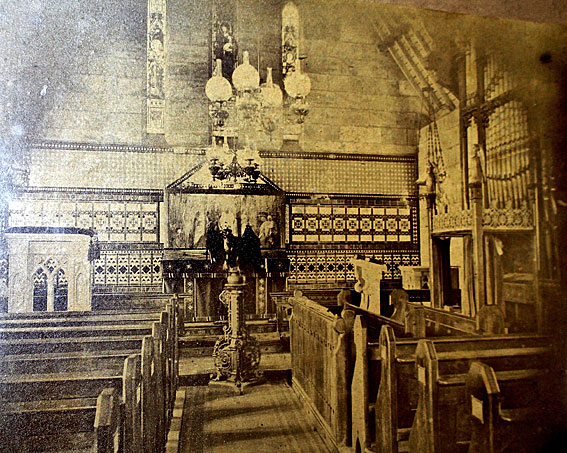
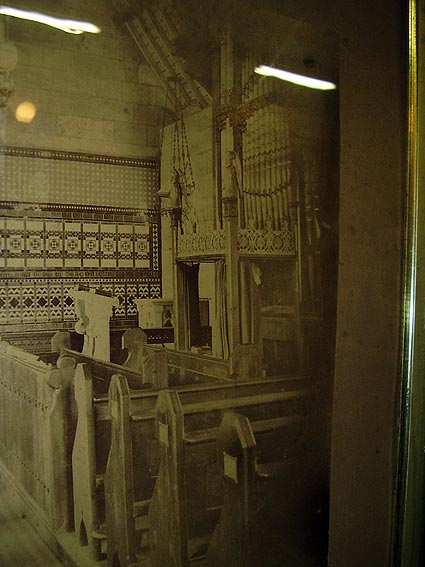
St Paul's Anglican Church, Murrurundi: 1876 organ
[photograph by Trevor Bunning (1 October 2015) from a photograph in the church]
The organ was built in 1876 by William Davidson of Sydney and examination of a photograph hanging on the wall of the nave reveals the casework design to be typical of Davidson's work and reminiscent in appearance of the builder's contemporary organs of St Paul's Cobbitty, St Clement's Yass (both still surviving) and the Stanmore Methodist Church (broken up in the mid-1970s).2 Rushworth records the organ as possessing a single manual, eight speaking stops and one coupler.3 As there are currently a similar number of speaking stops on the Great division, it seems likely that the pedal division (with a compass of 25 notes) originally had no stops, but played through a manual to pedal coupler.
The organ was damaged by fire on 23 March 1921 and this was clearly not extensive enough to have had a significant impact on the organ and church building, as both have survived with few scars.4 The organ was repaired and the Swell division added in 1923 by C.W. Leggo of Sydney at a cost of £270.5 Further documentary evidence of to account for the work of other organbuilders has yet to be uncovered, as aspects of the casework design are similar to some of the organs of Charles Richardson of Sydney, such as those of St Stephen's Presbyterian Church, East Maitland and St John's Anglican Church, Young. It is quite possible that the case was subcontracted to a cabinet maker who had made cases for either Richardson or Leggo. While the pipes of the Great division are by Davidson, Peter Jewkes notes that the metal Swell pipes are by Alfred Palmer & Sons of London.6
In 1963 S.T. Noad carried out an overhaul of the organ and in May 2008 Peter D. G. Jewkes Pty Ltd installed a new blower. The instrument exists today in a heavily-worn condition.7
The specification is as follows:
| GREAT Bourdon Open Diapason Rohr Flute Keraulophon Principal Rohr Flute Twelfth Fifteenth SWELL Horn Diapason Lieblich Gedackt Labial Oboe Gemshorn Tremulant PEDAL Bourdon |
16 8 [8] 8 4 4 2-2/3 2 [8] [8] [8] [4] 4 16 |
* # + = ~ > ** |
COUPLERS
Great to Pedal
Swell to Great
Mechanical action
Compass 56/25
3 composition pedals for Great
Hitch-down swell pedal
* To Tenor C
# Non-original dome. A Stopped Diapason 8
+ Bass octave from Rohr Flute 8
= Dome incorrectly shows 8' pitch
~ Bass octave from Lieblich Gedackt 8
> Gamba pipes voiced to produced imitative reed tone
**Very fluty tone, not unlike a 1960s Spitzflöte
1. Peter Reynolds, Lesley Muir and Joy Hughes, John Horbury Hunt: Radical Architect 1838-1904. Sydney: Historic Houses Trust of NSW, 2002, 60-61. Information provided by John Maidment. Other information from: http://www.upperhuntertourism.com.au/murrurundi/town-walk/. Accessed 26 August 2015.
2. Photograph cited by Peter Jewkes
3. Graeme D. Rushworth, Historic Organs of New South Wales (Sydney: Hale & Iremonger, 1998), page 117.
4. Maidment, Gazetteer of New South Wales Pipes Organs. Melbourne: Society of Organists (Vic.) Inc., 1981.
5. Rushworth, Historic Organs, 169.
6. Peter Jewkes, notes on the Murrurundi organ of September 2007 (see below)
7. Ibid. Peter Jewkes also supplied the annotated specification.
Peter Jewkes writes (September 2007):
As to the provenance, I would stake my life on the original one manual being Davidson. The pipes, soundboard and Swell shutters (now on the Richardson Swell) are beyond doubt. The case (as in the old sepia photo) is virtually identical to Cobbitty, and very similar to Noumea. The specification is identical to Morpeth, with the addition of the Twelfth, and the sound is remarkably similar. The Great keys are obviously the original single manual, and identical to Morpeth. With reference to the fire of 1921 - unless the present material is some other Davidson - I would say that the original organ wasn't all that badly damaged. I doubt the fire can have been all that severe, as the rather striking tiles in the sanctuary nearby are entirely unscathed.
Received wisdom (via Noad and Brown) is that the rebuild to two manuals (including the new case) was by Richardson, though the added wooden pipework doesn't look like his, the quality isn't great and there are other doubts in my mind. Leggo is a definite possibility, especially for the Gedackt, so it could also be an early example of his work, or done while he worked for Richardson. (Again I don't know the basis for his name in the entry - Rushworth?). The metal pipework for the Swell is by Palmer of London, with whom we know Richardson dealt occasionally (though Leggo dealt with them almost entirely). The case and the square-drop console lid look like Richardson however, so I think that is probably the safest attribution, unless someone has researched the church records (or the organ itself yields up some clues from deep within one day!).
The 1960s Noad restoration doesn't appear to have done much for the organ (other than that infelicitous Rohr Flute 8 stop knob for the 4' Flute - a real trap for noteholders, as the Stop Diapason is also called Rohr Flute, but without any pitch designation!).
We are adding a new blower late this year [installed May 2008], in place of an incredibly noisy external one. Hopefully one day the church will think about restoration......
Ian Brown writes (February 2016):
I remember going with Sid Noad a few times to St Paul's, Murrurundi. He always said that this organ was erected in Richardson's factory for several years, but this information does not appear to agree with the web site except that the present casework is almost certainly Richardson's work and the old photos show a case which is almost certainly Davidson's work. Davidson provided facade pipes of spotted metal at Cobbitty, Yass, Morpeth and elsewhere. One would presume that the facade pipes at Murrurundi were spotted metal with painted decorations as at the other places. The evidence of fire in this organ is still to be seen in scorch marks at the top of the Stopped Bass in the Great. The fire must have been high up in the building, so the facade and facade pipes would have been the highest point and it is easy to see that these would probably have been destroyed by the fire. The top half of the spotted metal pipes would have melted very quickly. The present facade pipes are quite different and differently arranged. I think perhaps one should take Mr Noad's information seriously. He said that it was in the front office at Richardson's and available as a demonstration instrument. Perhaps Richardson had finished the work on the organ but the building work at Murrurundi took a long time to complete.

St Paul's Anglican Church, Murrurundi: console
[photograph by Trevor Bunning (1 October 2015)]
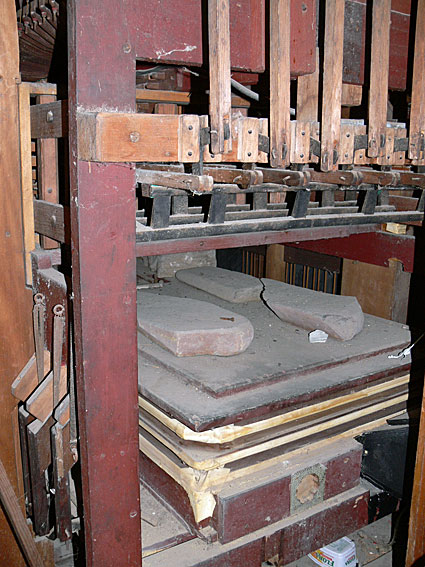
St Paul's Anglican Church, Murrurundi: wind reservoir and action
[photograph by John Maidment (1 October 2015)]
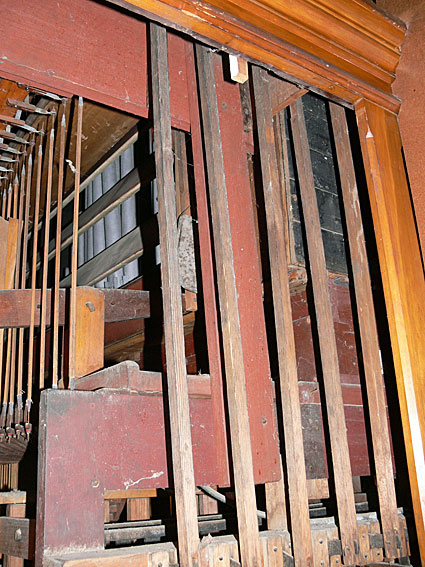
St Paul's Anglican Church, Murrurundi: action and swell box
[photograph by John Maidment (1 October 2015)]
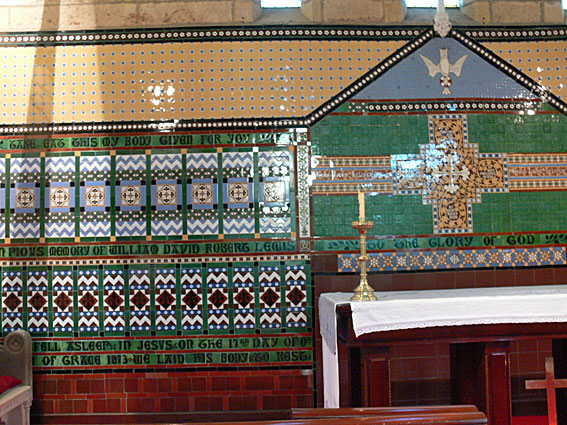
St Paul's Anglican Church, Murrurundi: east end of the church
[photograph by John Maidment (1 October 2015)]
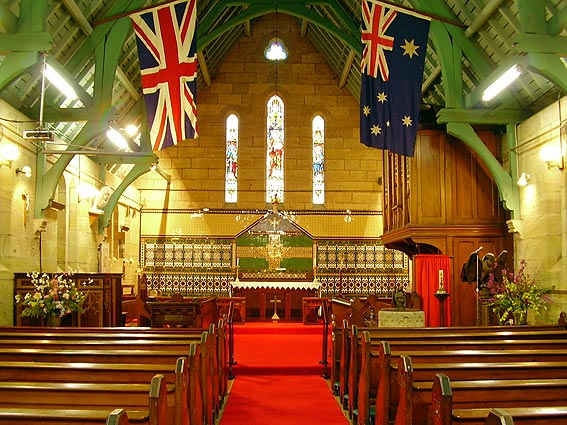
St Paul's Anglican Church, Murrurundi: east end of the church
[photograph by Peter Jewkes (September 2007)]
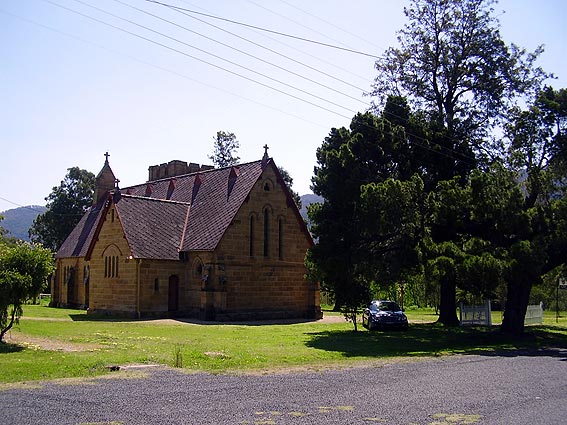
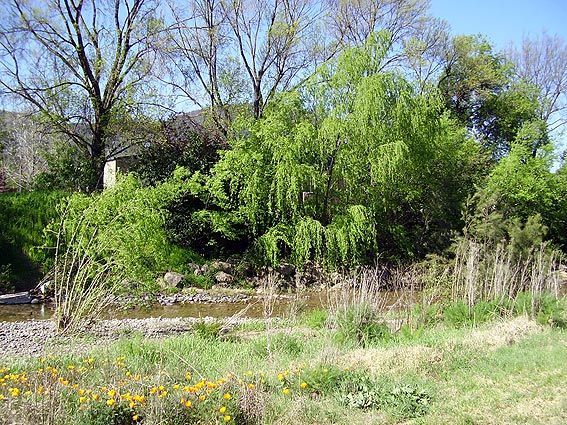
Page's River, about 100 metres from the church
[photographs by Peter Jewkes (September 2007)]
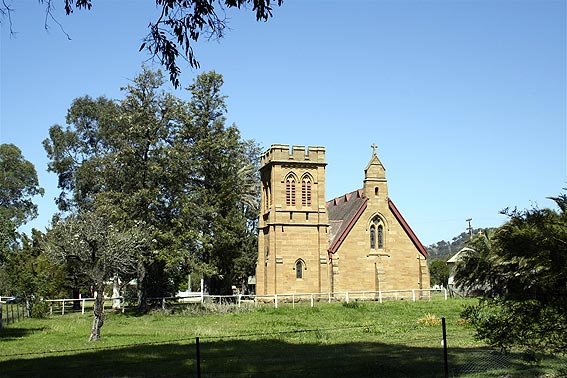
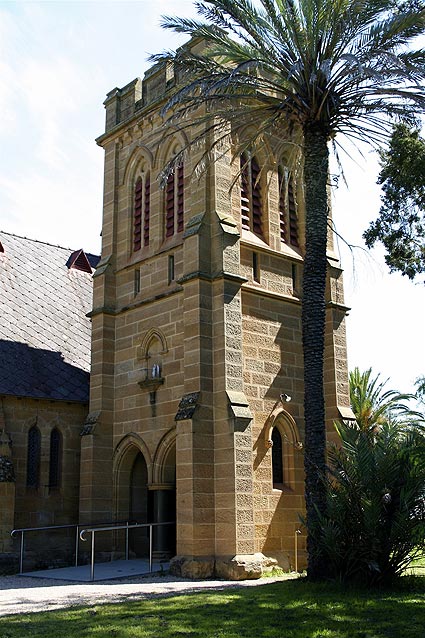
St Paul's Anglican Church, Murrurundi
[photographs by Peter Jewkes (September 2007)]